Spare Parts Planning and Control: A Case Study of Air India's Fleet
VerifiedAdded on 2023/01/10
|13
|4409
|75
Case Study
AI Summary
This case study examines the challenges faced by a fleet company, Air India, in managing its spare parts inventory. The report delves into current practices, including issues with multiple locations, spending on spare parts, and truck breakdowns. It explores key areas such as spare parts planning, effective inventory management and control, spare parts sales performance and tracking, risk assessment, and quality control. The study highlights the importance of inventory management, the use of fleet management software, and the role of telematics. It also discusses the current financial losses and storage space constraints. Recommendations for improvement are provided, including strategic planning and operational adjustments across the three workshop centers. The report emphasizes the need for optimized inventory levels, reduced costs, and streamlined purchasing processes to meet strategic goals and improve financial performance. This case study provides a detailed analysis of the problems faced by the company and suggests changes to improve its operational efficiency and financial standing.

Running head: SPARE PARTS PLANNING AND CONTROL
1
STUDENT NAME:
STUDENT ID:
TOPIC: SPARE PARTS PLANNING AND CONTROL (CASE STUDY)
DATE: 10-06-2019
1
STUDENT NAME:
STUDENT ID:
TOPIC: SPARE PARTS PLANNING AND CONTROL (CASE STUDY)
DATE: 10-06-2019
Paraphrase This Document
Need a fresh take? Get an instant paraphrase of this document with our AI Paraphraser
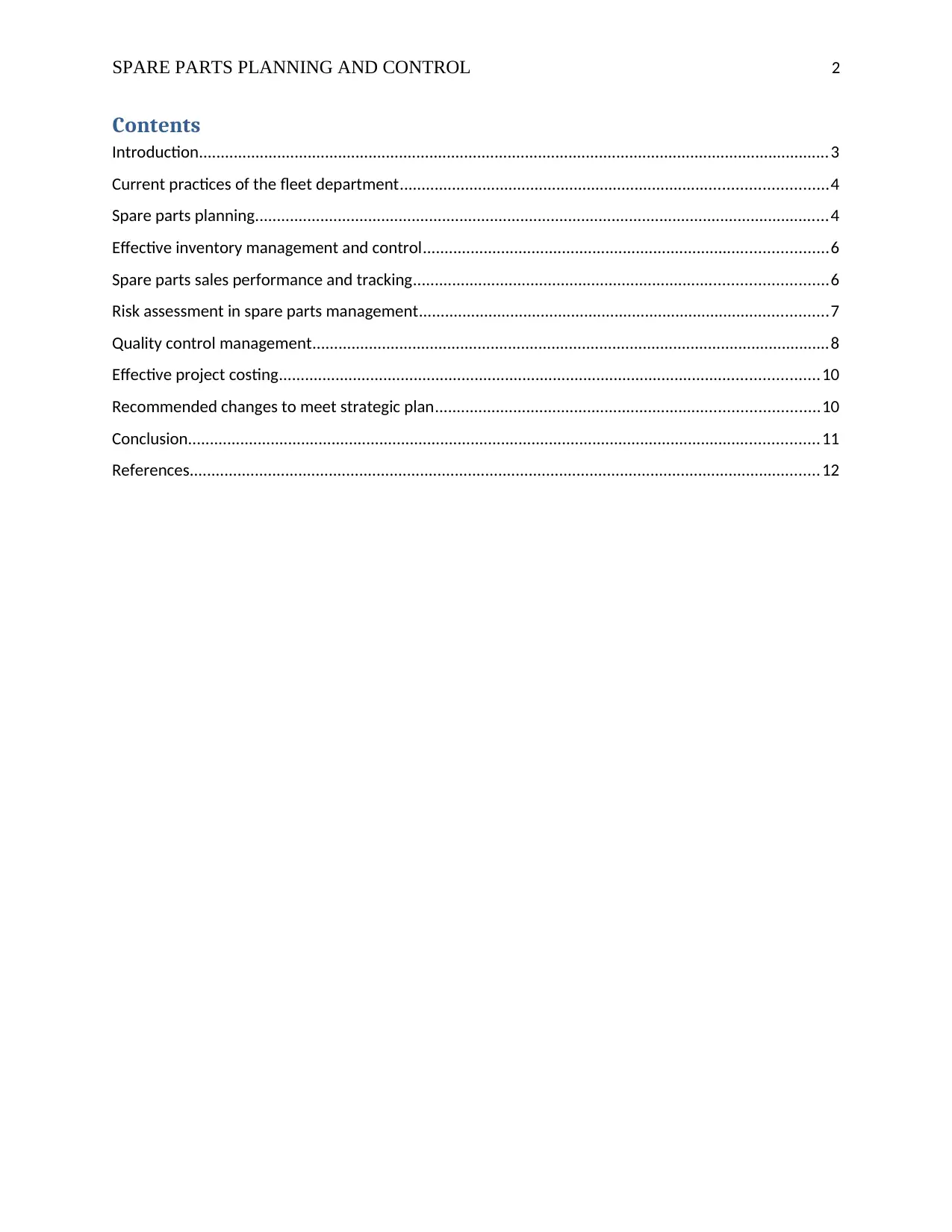
SPARE PARTS PLANNING AND CONTROL 2
Contents
Introduction.................................................................................................................................................3
Current practices of the fleet department..................................................................................................4
Spare parts planning....................................................................................................................................4
Effective inventory management and control.............................................................................................6
Spare parts sales performance and tracking...............................................................................................6
Risk assessment in spare parts management..............................................................................................7
Quality control management.......................................................................................................................8
Effective project costing............................................................................................................................10
Recommended changes to meet strategic plan........................................................................................10
Conclusion.................................................................................................................................................11
References.................................................................................................................................................12
Contents
Introduction.................................................................................................................................................3
Current practices of the fleet department..................................................................................................4
Spare parts planning....................................................................................................................................4
Effective inventory management and control.............................................................................................6
Spare parts sales performance and tracking...............................................................................................6
Risk assessment in spare parts management..............................................................................................7
Quality control management.......................................................................................................................8
Effective project costing............................................................................................................................10
Recommended changes to meet strategic plan........................................................................................10
Conclusion.................................................................................................................................................11
References.................................................................................................................................................12
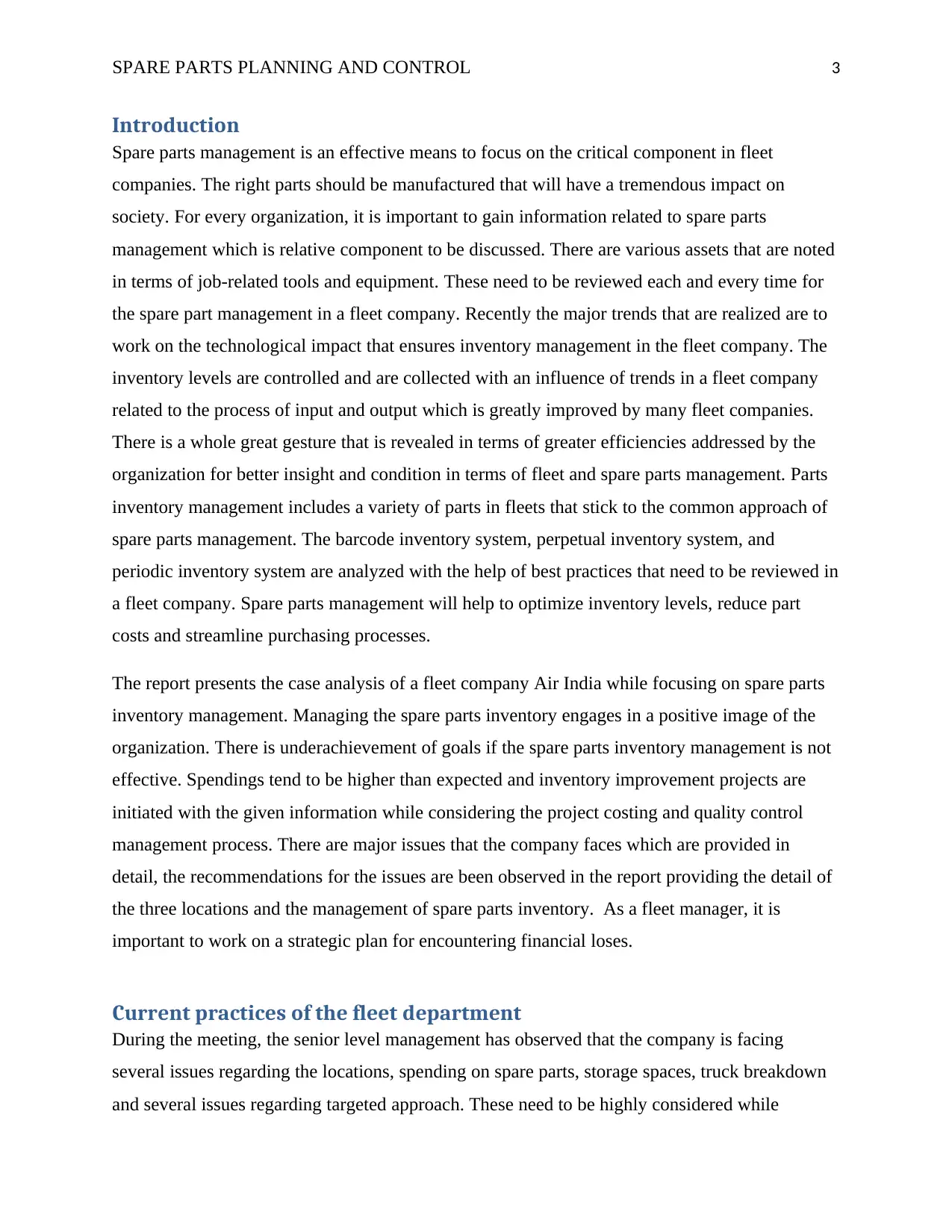
SPARE PARTS PLANNING AND CONTROL 3
Introduction
Spare parts management is an effective means to focus on the critical component in fleet
companies. The right parts should be manufactured that will have a tremendous impact on
society. For every organization, it is important to gain information related to spare parts
management which is relative component to be discussed. There are various assets that are noted
in terms of job-related tools and equipment. These need to be reviewed each and every time for
the spare part management in a fleet company. Recently the major trends that are realized are to
work on the technological impact that ensures inventory management in the fleet company. The
inventory levels are controlled and are collected with an influence of trends in a fleet company
related to the process of input and output which is greatly improved by many fleet companies.
There is a whole great gesture that is revealed in terms of greater efficiencies addressed by the
organization for better insight and condition in terms of fleet and spare parts management. Parts
inventory management includes a variety of parts in fleets that stick to the common approach of
spare parts management. The barcode inventory system, perpetual inventory system, and
periodic inventory system are analyzed with the help of best practices that need to be reviewed in
a fleet company. Spare parts management will help to optimize inventory levels, reduce part
costs and streamline purchasing processes.
The report presents the case analysis of a fleet company Air India while focusing on spare parts
inventory management. Managing the spare parts inventory engages in a positive image of the
organization. There is underachievement of goals if the spare parts inventory management is not
effective. Spendings tend to be higher than expected and inventory improvement projects are
initiated with the given information while considering the project costing and quality control
management process. There are major issues that the company faces which are provided in
detail, the recommendations for the issues are been observed in the report providing the detail of
the three locations and the management of spare parts inventory. As a fleet manager, it is
important to work on a strategic plan for encountering financial loses.
Current practices of the fleet department
During the meeting, the senior level management has observed that the company is facing
several issues regarding the locations, spending on spare parts, storage spaces, truck breakdown
and several issues regarding targeted approach. These need to be highly considered while
Introduction
Spare parts management is an effective means to focus on the critical component in fleet
companies. The right parts should be manufactured that will have a tremendous impact on
society. For every organization, it is important to gain information related to spare parts
management which is relative component to be discussed. There are various assets that are noted
in terms of job-related tools and equipment. These need to be reviewed each and every time for
the spare part management in a fleet company. Recently the major trends that are realized are to
work on the technological impact that ensures inventory management in the fleet company. The
inventory levels are controlled and are collected with an influence of trends in a fleet company
related to the process of input and output which is greatly improved by many fleet companies.
There is a whole great gesture that is revealed in terms of greater efficiencies addressed by the
organization for better insight and condition in terms of fleet and spare parts management. Parts
inventory management includes a variety of parts in fleets that stick to the common approach of
spare parts management. The barcode inventory system, perpetual inventory system, and
periodic inventory system are analyzed with the help of best practices that need to be reviewed in
a fleet company. Spare parts management will help to optimize inventory levels, reduce part
costs and streamline purchasing processes.
The report presents the case analysis of a fleet company Air India while focusing on spare parts
inventory management. Managing the spare parts inventory engages in a positive image of the
organization. There is underachievement of goals if the spare parts inventory management is not
effective. Spendings tend to be higher than expected and inventory improvement projects are
initiated with the given information while considering the project costing and quality control
management process. There are major issues that the company faces which are provided in
detail, the recommendations for the issues are been observed in the report providing the detail of
the three locations and the management of spare parts inventory. As a fleet manager, it is
important to work on a strategic plan for encountering financial loses.
Current practices of the fleet department
During the meeting, the senior level management has observed that the company is facing
several issues regarding the locations, spending on spare parts, storage spaces, truck breakdown
and several issues regarding targeted approach. These need to be highly considered while
⊘ This is a preview!⊘
Do you want full access?
Subscribe today to unlock all pages.

Trusted by 1+ million students worldwide
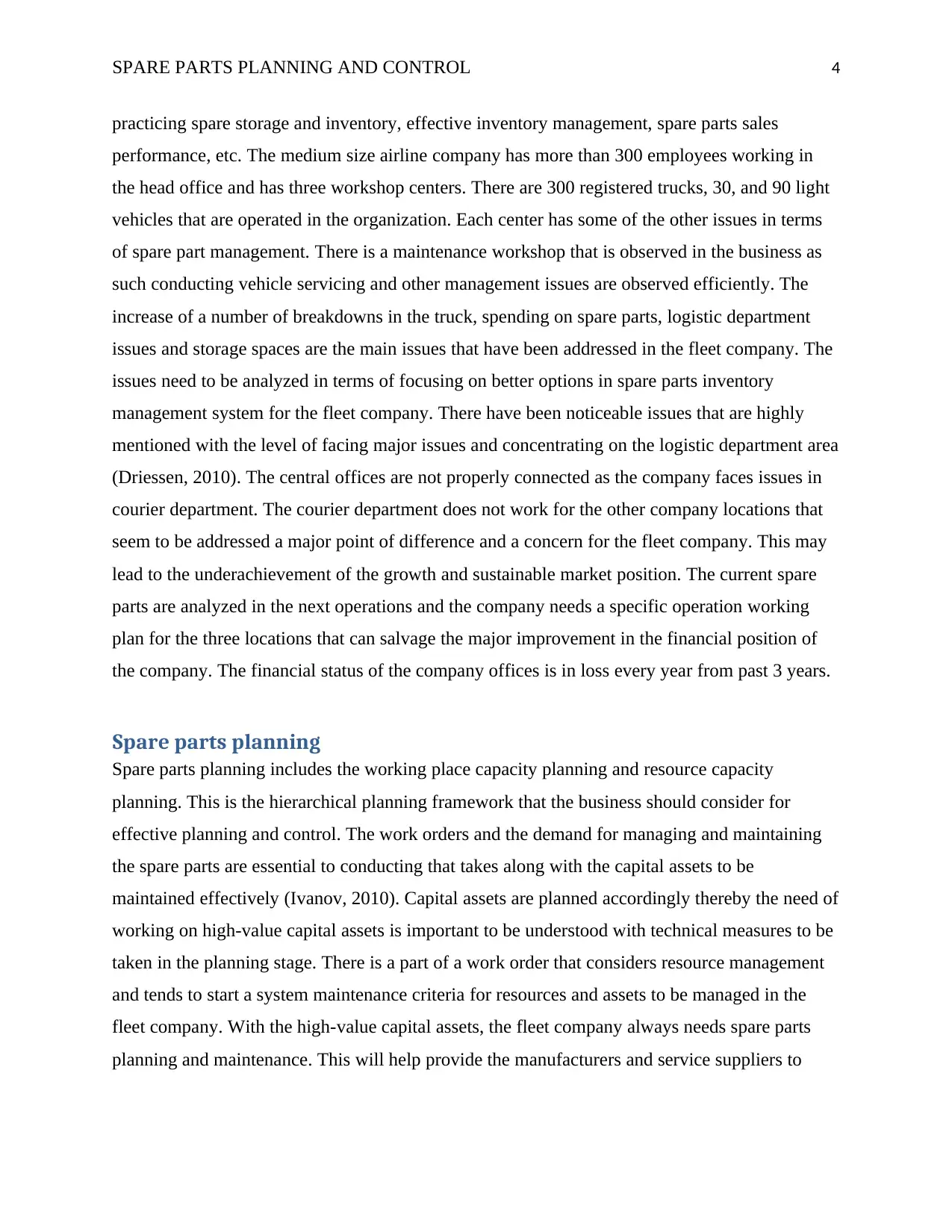
SPARE PARTS PLANNING AND CONTROL 4
practicing spare storage and inventory, effective inventory management, spare parts sales
performance, etc. The medium size airline company has more than 300 employees working in
the head office and has three workshop centers. There are 300 registered trucks, 30, and 90 light
vehicles that are operated in the organization. Each center has some of the other issues in terms
of spare part management. There is a maintenance workshop that is observed in the business as
such conducting vehicle servicing and other management issues are observed efficiently. The
increase of a number of breakdowns in the truck, spending on spare parts, logistic department
issues and storage spaces are the main issues that have been addressed in the fleet company. The
issues need to be analyzed in terms of focusing on better options in spare parts inventory
management system for the fleet company. There have been noticeable issues that are highly
mentioned with the level of facing major issues and concentrating on the logistic department area
(Driessen, 2010). The central offices are not properly connected as the company faces issues in
courier department. The courier department does not work for the other company locations that
seem to be addressed a major point of difference and a concern for the fleet company. This may
lead to the underachievement of the growth and sustainable market position. The current spare
parts are analyzed in the next operations and the company needs a specific operation working
plan for the three locations that can salvage the major improvement in the financial position of
the company. The financial status of the company offices is in loss every year from past 3 years.
Spare parts planning
Spare parts planning includes the working place capacity planning and resource capacity
planning. This is the hierarchical planning framework that the business should consider for
effective planning and control. The work orders and the demand for managing and maintaining
the spare parts are essential to conducting that takes along with the capital assets to be
maintained effectively (Ivanov, 2010). Capital assets are planned accordingly thereby the need of
working on high-value capital assets is important to be understood with technical measures to be
taken in the planning stage. There is a part of a work order that considers resource management
and tends to start a system maintenance criteria for resources and assets to be managed in the
fleet company. With the high-value capital assets, the fleet company always needs spare parts
planning and maintenance. This will help provide the manufacturers and service suppliers to
practicing spare storage and inventory, effective inventory management, spare parts sales
performance, etc. The medium size airline company has more than 300 employees working in
the head office and has three workshop centers. There are 300 registered trucks, 30, and 90 light
vehicles that are operated in the organization. Each center has some of the other issues in terms
of spare part management. There is a maintenance workshop that is observed in the business as
such conducting vehicle servicing and other management issues are observed efficiently. The
increase of a number of breakdowns in the truck, spending on spare parts, logistic department
issues and storage spaces are the main issues that have been addressed in the fleet company. The
issues need to be analyzed in terms of focusing on better options in spare parts inventory
management system for the fleet company. There have been noticeable issues that are highly
mentioned with the level of facing major issues and concentrating on the logistic department area
(Driessen, 2010). The central offices are not properly connected as the company faces issues in
courier department. The courier department does not work for the other company locations that
seem to be addressed a major point of difference and a concern for the fleet company. This may
lead to the underachievement of the growth and sustainable market position. The current spare
parts are analyzed in the next operations and the company needs a specific operation working
plan for the three locations that can salvage the major improvement in the financial position of
the company. The financial status of the company offices is in loss every year from past 3 years.
Spare parts planning
Spare parts planning includes the working place capacity planning and resource capacity
planning. This is the hierarchical planning framework that the business should consider for
effective planning and control. The work orders and the demand for managing and maintaining
the spare parts are essential to conducting that takes along with the capital assets to be
maintained effectively (Ivanov, 2010). Capital assets are planned accordingly thereby the need of
working on high-value capital assets is important to be understood with technical measures to be
taken in the planning stage. There is a part of a work order that considers resource management
and tends to start a system maintenance criteria for resources and assets to be managed in the
fleet company. With the high-value capital assets, the fleet company always needs spare parts
planning and maintenance. This will help provide the manufacturers and service suppliers to
Paraphrase This Document
Need a fresh take? Get an instant paraphrase of this document with our AI Paraphraser
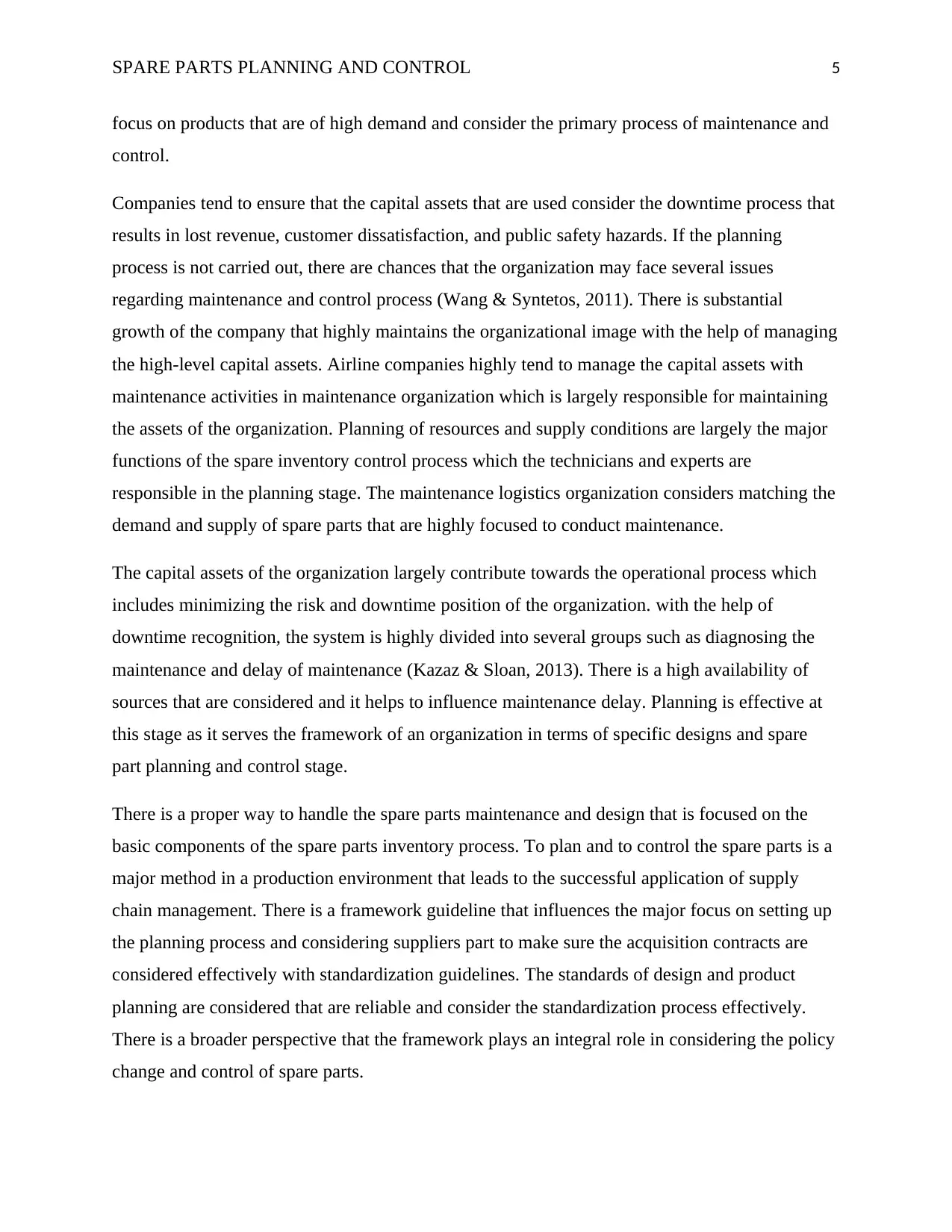
SPARE PARTS PLANNING AND CONTROL 5
focus on products that are of high demand and consider the primary process of maintenance and
control.
Companies tend to ensure that the capital assets that are used consider the downtime process that
results in lost revenue, customer dissatisfaction, and public safety hazards. If the planning
process is not carried out, there are chances that the organization may face several issues
regarding maintenance and control process (Wang & Syntetos, 2011). There is substantial
growth of the company that highly maintains the organizational image with the help of managing
the high-level capital assets. Airline companies highly tend to manage the capital assets with
maintenance activities in maintenance organization which is largely responsible for maintaining
the assets of the organization. Planning of resources and supply conditions are largely the major
functions of the spare inventory control process which the technicians and experts are
responsible in the planning stage. The maintenance logistics organization considers matching the
demand and supply of spare parts that are highly focused to conduct maintenance.
The capital assets of the organization largely contribute towards the operational process which
includes minimizing the risk and downtime position of the organization. with the help of
downtime recognition, the system is highly divided into several groups such as diagnosing the
maintenance and delay of maintenance (Kazaz & Sloan, 2013). There is a high availability of
sources that are considered and it helps to influence maintenance delay. Planning is effective at
this stage as it serves the framework of an organization in terms of specific designs and spare
part planning and control stage.
There is a proper way to handle the spare parts maintenance and design that is focused on the
basic components of the spare parts inventory process. To plan and to control the spare parts is a
major method in a production environment that leads to the successful application of supply
chain management. There is a framework guideline that influences the major focus on setting up
the planning process and considering suppliers part to make sure the acquisition contracts are
considered effectively with standardization guidelines. The standards of design and product
planning are considered that are reliable and consider the standardization process effectively.
There is a broader perspective that the framework plays an integral role in considering the policy
change and control of spare parts.
focus on products that are of high demand and consider the primary process of maintenance and
control.
Companies tend to ensure that the capital assets that are used consider the downtime process that
results in lost revenue, customer dissatisfaction, and public safety hazards. If the planning
process is not carried out, there are chances that the organization may face several issues
regarding maintenance and control process (Wang & Syntetos, 2011). There is substantial
growth of the company that highly maintains the organizational image with the help of managing
the high-level capital assets. Airline companies highly tend to manage the capital assets with
maintenance activities in maintenance organization which is largely responsible for maintaining
the assets of the organization. Planning of resources and supply conditions are largely the major
functions of the spare inventory control process which the technicians and experts are
responsible in the planning stage. The maintenance logistics organization considers matching the
demand and supply of spare parts that are highly focused to conduct maintenance.
The capital assets of the organization largely contribute towards the operational process which
includes minimizing the risk and downtime position of the organization. with the help of
downtime recognition, the system is highly divided into several groups such as diagnosing the
maintenance and delay of maintenance (Kazaz & Sloan, 2013). There is a high availability of
sources that are considered and it helps to influence maintenance delay. Planning is effective at
this stage as it serves the framework of an organization in terms of specific designs and spare
part planning and control stage.
There is a proper way to handle the spare parts maintenance and design that is focused on the
basic components of the spare parts inventory process. To plan and to control the spare parts is a
major method in a production environment that leads to the successful application of supply
chain management. There is a framework guideline that influences the major focus on setting up
the planning process and considering suppliers part to make sure the acquisition contracts are
considered effectively with standardization guidelines. The standards of design and product
planning are considered that are reliable and consider the standardization process effectively.
There is a broader perspective that the framework plays an integral role in considering the policy
change and control of spare parts.
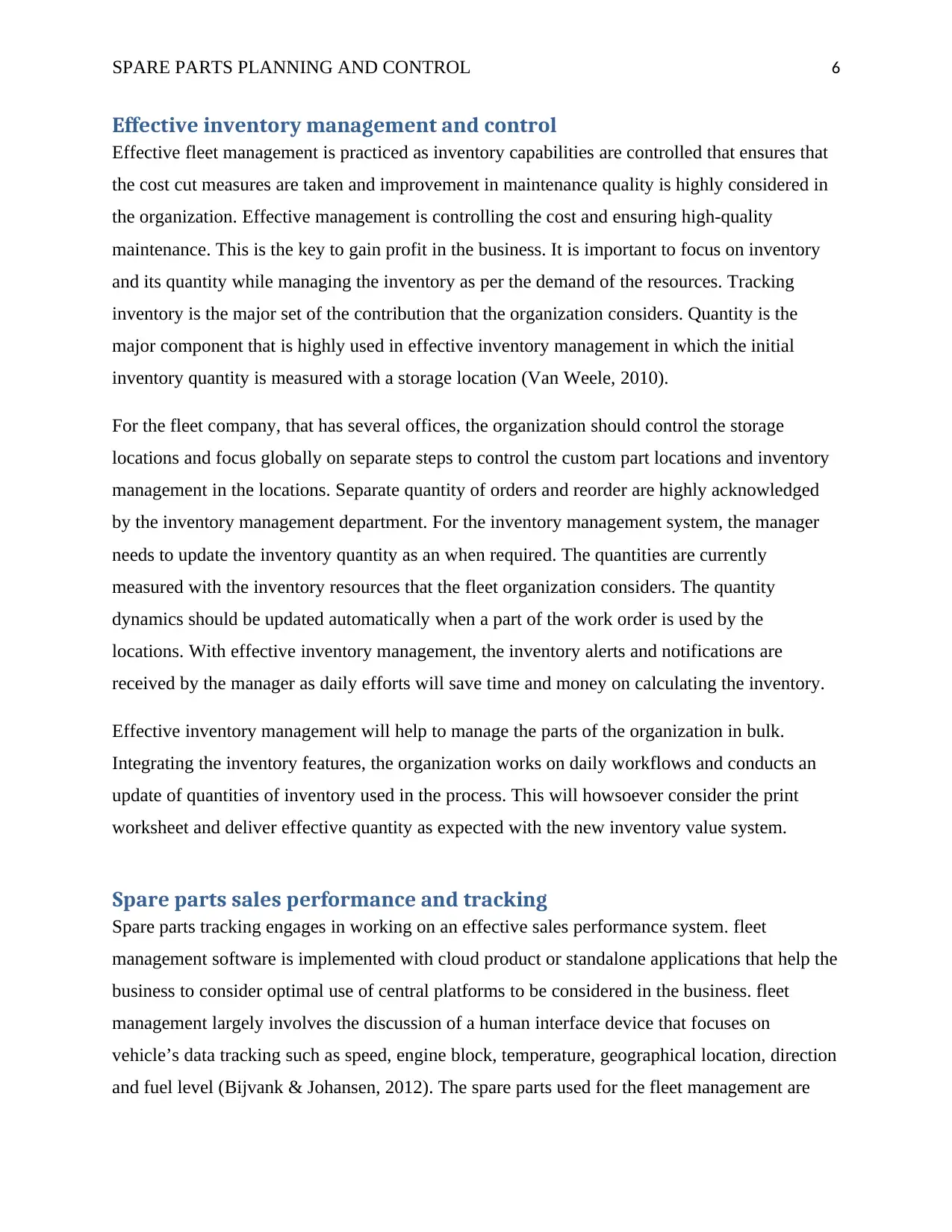
SPARE PARTS PLANNING AND CONTROL 6
Effective inventory management and control
Effective fleet management is practiced as inventory capabilities are controlled that ensures that
the cost cut measures are taken and improvement in maintenance quality is highly considered in
the organization. Effective management is controlling the cost and ensuring high-quality
maintenance. This is the key to gain profit in the business. It is important to focus on inventory
and its quantity while managing the inventory as per the demand of the resources. Tracking
inventory is the major set of the contribution that the organization considers. Quantity is the
major component that is highly used in effective inventory management in which the initial
inventory quantity is measured with a storage location (Van Weele, 2010).
For the fleet company, that has several offices, the organization should control the storage
locations and focus globally on separate steps to control the custom part locations and inventory
management in the locations. Separate quantity of orders and reorder are highly acknowledged
by the inventory management department. For the inventory management system, the manager
needs to update the inventory quantity as an when required. The quantities are currently
measured with the inventory resources that the fleet organization considers. The quantity
dynamics should be updated automatically when a part of the work order is used by the
locations. With effective inventory management, the inventory alerts and notifications are
received by the manager as daily efforts will save time and money on calculating the inventory.
Effective inventory management will help to manage the parts of the organization in bulk.
Integrating the inventory features, the organization works on daily workflows and conducts an
update of quantities of inventory used in the process. This will howsoever consider the print
worksheet and deliver effective quantity as expected with the new inventory value system.
Spare parts sales performance and tracking
Spare parts tracking engages in working on an effective sales performance system. fleet
management software is implemented with cloud product or standalone applications that help the
business to consider optimal use of central platforms to be considered in the business. fleet
management largely involves the discussion of a human interface device that focuses on
vehicle’s data tracking such as speed, engine block, temperature, geographical location, direction
and fuel level (Bijvank & Johansen, 2012). The spare parts used for the fleet management are
Effective inventory management and control
Effective fleet management is practiced as inventory capabilities are controlled that ensures that
the cost cut measures are taken and improvement in maintenance quality is highly considered in
the organization. Effective management is controlling the cost and ensuring high-quality
maintenance. This is the key to gain profit in the business. It is important to focus on inventory
and its quantity while managing the inventory as per the demand of the resources. Tracking
inventory is the major set of the contribution that the organization considers. Quantity is the
major component that is highly used in effective inventory management in which the initial
inventory quantity is measured with a storage location (Van Weele, 2010).
For the fleet company, that has several offices, the organization should control the storage
locations and focus globally on separate steps to control the custom part locations and inventory
management in the locations. Separate quantity of orders and reorder are highly acknowledged
by the inventory management department. For the inventory management system, the manager
needs to update the inventory quantity as an when required. The quantities are currently
measured with the inventory resources that the fleet organization considers. The quantity
dynamics should be updated automatically when a part of the work order is used by the
locations. With effective inventory management, the inventory alerts and notifications are
received by the manager as daily efforts will save time and money on calculating the inventory.
Effective inventory management will help to manage the parts of the organization in bulk.
Integrating the inventory features, the organization works on daily workflows and conducts an
update of quantities of inventory used in the process. This will howsoever consider the print
worksheet and deliver effective quantity as expected with the new inventory value system.
Spare parts sales performance and tracking
Spare parts tracking engages in working on an effective sales performance system. fleet
management software is implemented with cloud product or standalone applications that help the
business to consider optimal use of central platforms to be considered in the business. fleet
management largely involves the discussion of a human interface device that focuses on
vehicle’s data tracking such as speed, engine block, temperature, geographical location, direction
and fuel level (Bijvank & Johansen, 2012). The spare parts used for the fleet management are
⊘ This is a preview!⊘
Do you want full access?
Subscribe today to unlock all pages.

Trusted by 1+ million students worldwide
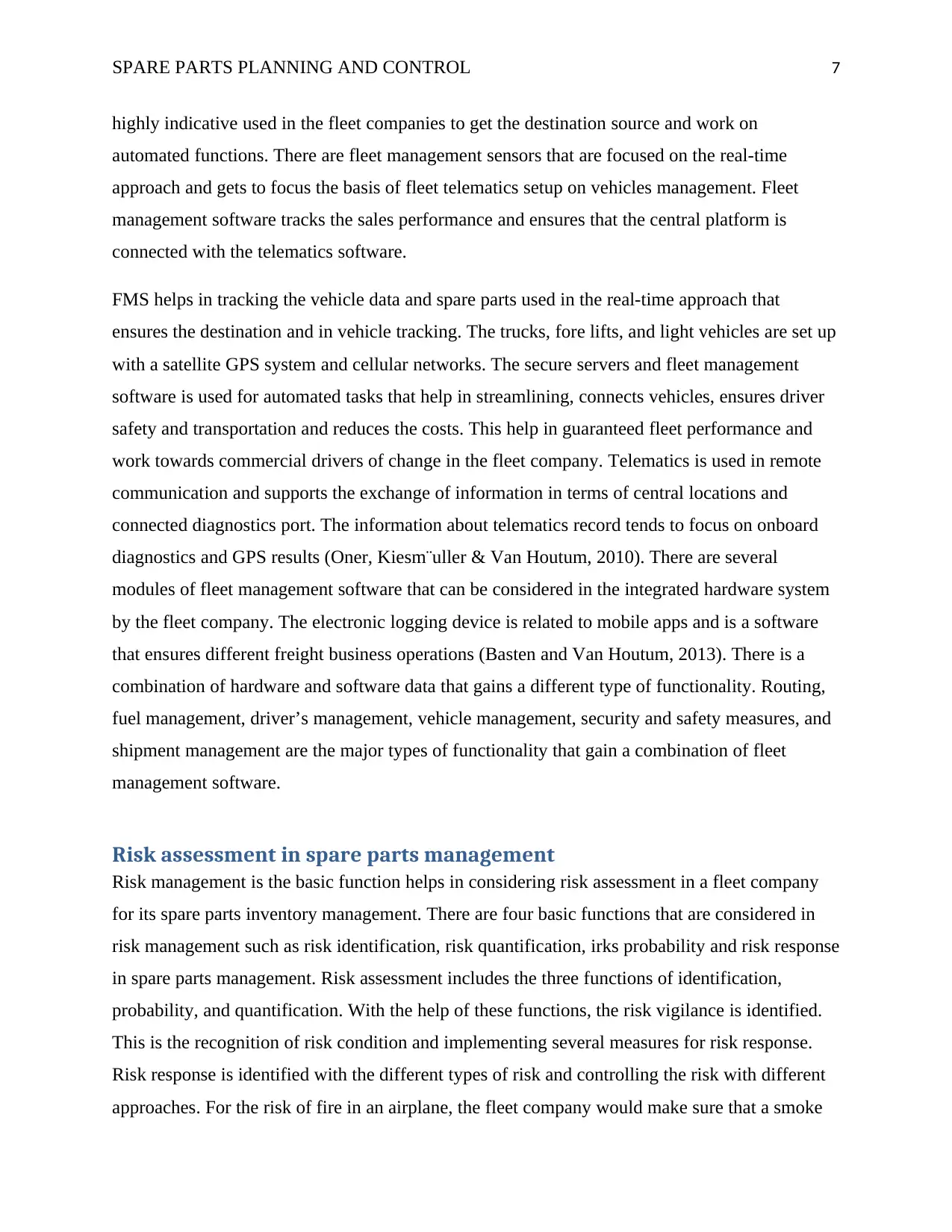
SPARE PARTS PLANNING AND CONTROL 7
highly indicative used in the fleet companies to get the destination source and work on
automated functions. There are fleet management sensors that are focused on the real-time
approach and gets to focus the basis of fleet telematics setup on vehicles management. Fleet
management software tracks the sales performance and ensures that the central platform is
connected with the telematics software.
FMS helps in tracking the vehicle data and spare parts used in the real-time approach that
ensures the destination and in vehicle tracking. The trucks, fore lifts, and light vehicles are set up
with a satellite GPS system and cellular networks. The secure servers and fleet management
software is used for automated tasks that help in streamlining, connects vehicles, ensures driver
safety and transportation and reduces the costs. This help in guaranteed fleet performance and
work towards commercial drivers of change in the fleet company. Telematics is used in remote
communication and supports the exchange of information in terms of central locations and
connected diagnostics port. The information about telematics record tends to focus on onboard
diagnostics and GPS results (Oner, Kiesm¨uller & Van Houtum, 2010). There are several
modules of fleet management software that can be considered in the integrated hardware system
by the fleet company. The electronic logging device is related to mobile apps and is a software
that ensures different freight business operations (Basten and Van Houtum, 2013). There is a
combination of hardware and software data that gains a different type of functionality. Routing,
fuel management, driver’s management, vehicle management, security and safety measures, and
shipment management are the major types of functionality that gain a combination of fleet
management software.
Risk assessment in spare parts management
Risk management is the basic function helps in considering risk assessment in a fleet company
for its spare parts inventory management. There are four basic functions that are considered in
risk management such as risk identification, risk quantification, irks probability and risk response
in spare parts management. Risk assessment includes the three functions of identification,
probability, and quantification. With the help of these functions, the risk vigilance is identified.
This is the recognition of risk condition and implementing several measures for risk response.
Risk response is identified with the different types of risk and controlling the risk with different
approaches. For the risk of fire in an airplane, the fleet company would make sure that a smoke
highly indicative used in the fleet companies to get the destination source and work on
automated functions. There are fleet management sensors that are focused on the real-time
approach and gets to focus the basis of fleet telematics setup on vehicles management. Fleet
management software tracks the sales performance and ensures that the central platform is
connected with the telematics software.
FMS helps in tracking the vehicle data and spare parts used in the real-time approach that
ensures the destination and in vehicle tracking. The trucks, fore lifts, and light vehicles are set up
with a satellite GPS system and cellular networks. The secure servers and fleet management
software is used for automated tasks that help in streamlining, connects vehicles, ensures driver
safety and transportation and reduces the costs. This help in guaranteed fleet performance and
work towards commercial drivers of change in the fleet company. Telematics is used in remote
communication and supports the exchange of information in terms of central locations and
connected diagnostics port. The information about telematics record tends to focus on onboard
diagnostics and GPS results (Oner, Kiesm¨uller & Van Houtum, 2010). There are several
modules of fleet management software that can be considered in the integrated hardware system
by the fleet company. The electronic logging device is related to mobile apps and is a software
that ensures different freight business operations (Basten and Van Houtum, 2013). There is a
combination of hardware and software data that gains a different type of functionality. Routing,
fuel management, driver’s management, vehicle management, security and safety measures, and
shipment management are the major types of functionality that gain a combination of fleet
management software.
Risk assessment in spare parts management
Risk management is the basic function helps in considering risk assessment in a fleet company
for its spare parts inventory management. There are four basic functions that are considered in
risk management such as risk identification, risk quantification, irks probability and risk response
in spare parts management. Risk assessment includes the three functions of identification,
probability, and quantification. With the help of these functions, the risk vigilance is identified.
This is the recognition of risk condition and implementing several measures for risk response.
Risk response is identified with the different types of risk and controlling the risk with different
approaches. For the risk of fire in an airplane, the fleet company would make sure that a smoke
Paraphrase This Document
Need a fresh take? Get an instant paraphrase of this document with our AI Paraphraser
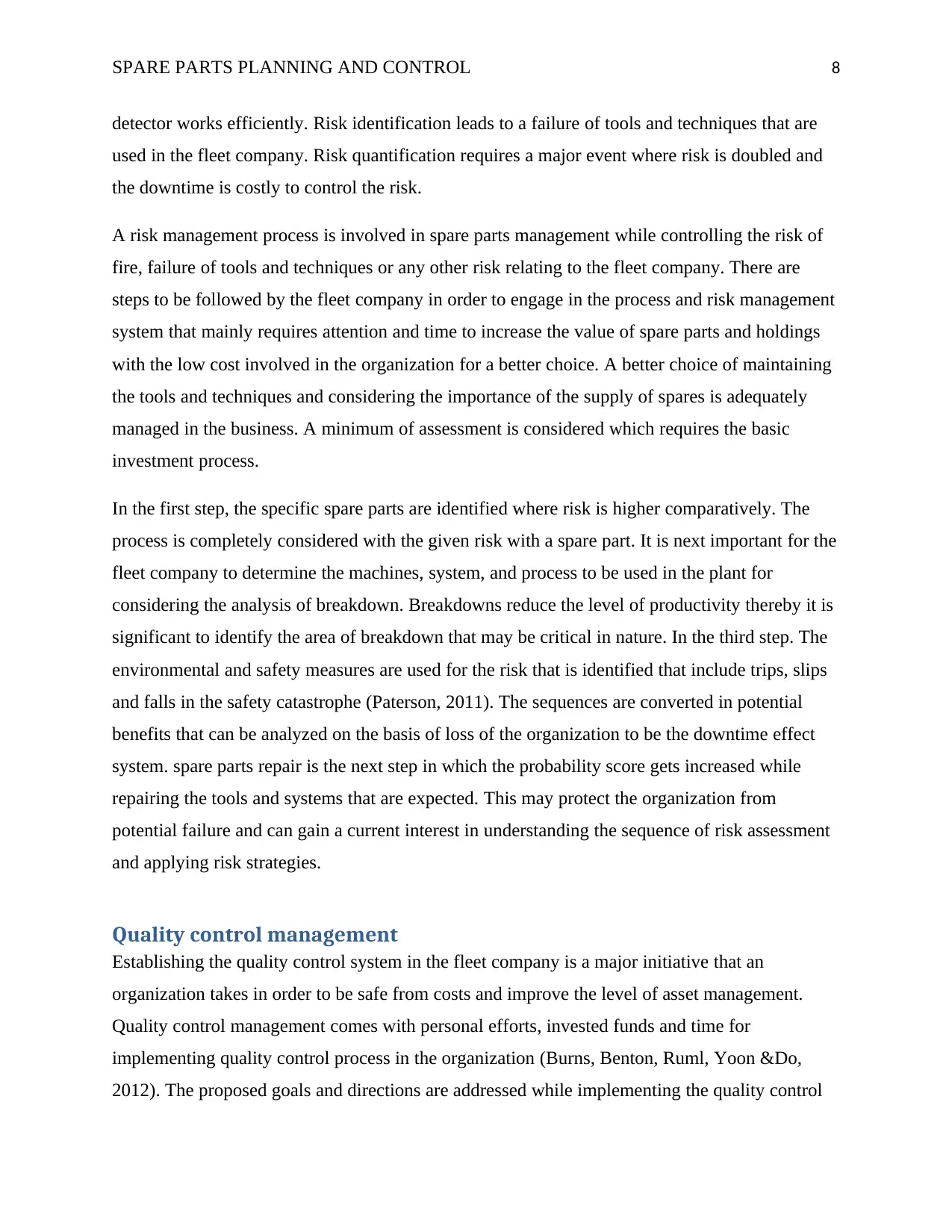
SPARE PARTS PLANNING AND CONTROL 8
detector works efficiently. Risk identification leads to a failure of tools and techniques that are
used in the fleet company. Risk quantification requires a major event where risk is doubled and
the downtime is costly to control the risk.
A risk management process is involved in spare parts management while controlling the risk of
fire, failure of tools and techniques or any other risk relating to the fleet company. There are
steps to be followed by the fleet company in order to engage in the process and risk management
system that mainly requires attention and time to increase the value of spare parts and holdings
with the low cost involved in the organization for a better choice. A better choice of maintaining
the tools and techniques and considering the importance of the supply of spares is adequately
managed in the business. A minimum of assessment is considered which requires the basic
investment process.
In the first step, the specific spare parts are identified where risk is higher comparatively. The
process is completely considered with the given risk with a spare part. It is next important for the
fleet company to determine the machines, system, and process to be used in the plant for
considering the analysis of breakdown. Breakdowns reduce the level of productivity thereby it is
significant to identify the area of breakdown that may be critical in nature. In the third step. The
environmental and safety measures are used for the risk that is identified that include trips, slips
and falls in the safety catastrophe (Paterson, 2011). The sequences are converted in potential
benefits that can be analyzed on the basis of loss of the organization to be the downtime effect
system. spare parts repair is the next step in which the probability score gets increased while
repairing the tools and systems that are expected. This may protect the organization from
potential failure and can gain a current interest in understanding the sequence of risk assessment
and applying risk strategies.
Quality control management
Establishing the quality control system in the fleet company is a major initiative that an
organization takes in order to be safe from costs and improve the level of asset management.
Quality control management comes with personal efforts, invested funds and time for
implementing quality control process in the organization (Burns, Benton, Ruml, Yoon &Do,
2012). The proposed goals and directions are addressed while implementing the quality control
detector works efficiently. Risk identification leads to a failure of tools and techniques that are
used in the fleet company. Risk quantification requires a major event where risk is doubled and
the downtime is costly to control the risk.
A risk management process is involved in spare parts management while controlling the risk of
fire, failure of tools and techniques or any other risk relating to the fleet company. There are
steps to be followed by the fleet company in order to engage in the process and risk management
system that mainly requires attention and time to increase the value of spare parts and holdings
with the low cost involved in the organization for a better choice. A better choice of maintaining
the tools and techniques and considering the importance of the supply of spares is adequately
managed in the business. A minimum of assessment is considered which requires the basic
investment process.
In the first step, the specific spare parts are identified where risk is higher comparatively. The
process is completely considered with the given risk with a spare part. It is next important for the
fleet company to determine the machines, system, and process to be used in the plant for
considering the analysis of breakdown. Breakdowns reduce the level of productivity thereby it is
significant to identify the area of breakdown that may be critical in nature. In the third step. The
environmental and safety measures are used for the risk that is identified that include trips, slips
and falls in the safety catastrophe (Paterson, 2011). The sequences are converted in potential
benefits that can be analyzed on the basis of loss of the organization to be the downtime effect
system. spare parts repair is the next step in which the probability score gets increased while
repairing the tools and systems that are expected. This may protect the organization from
potential failure and can gain a current interest in understanding the sequence of risk assessment
and applying risk strategies.
Quality control management
Establishing the quality control system in the fleet company is a major initiative that an
organization takes in order to be safe from costs and improve the level of asset management.
Quality control management comes with personal efforts, invested funds and time for
implementing quality control process in the organization (Burns, Benton, Ruml, Yoon &Do,
2012). The proposed goals and directions are addressed while implementing the quality control
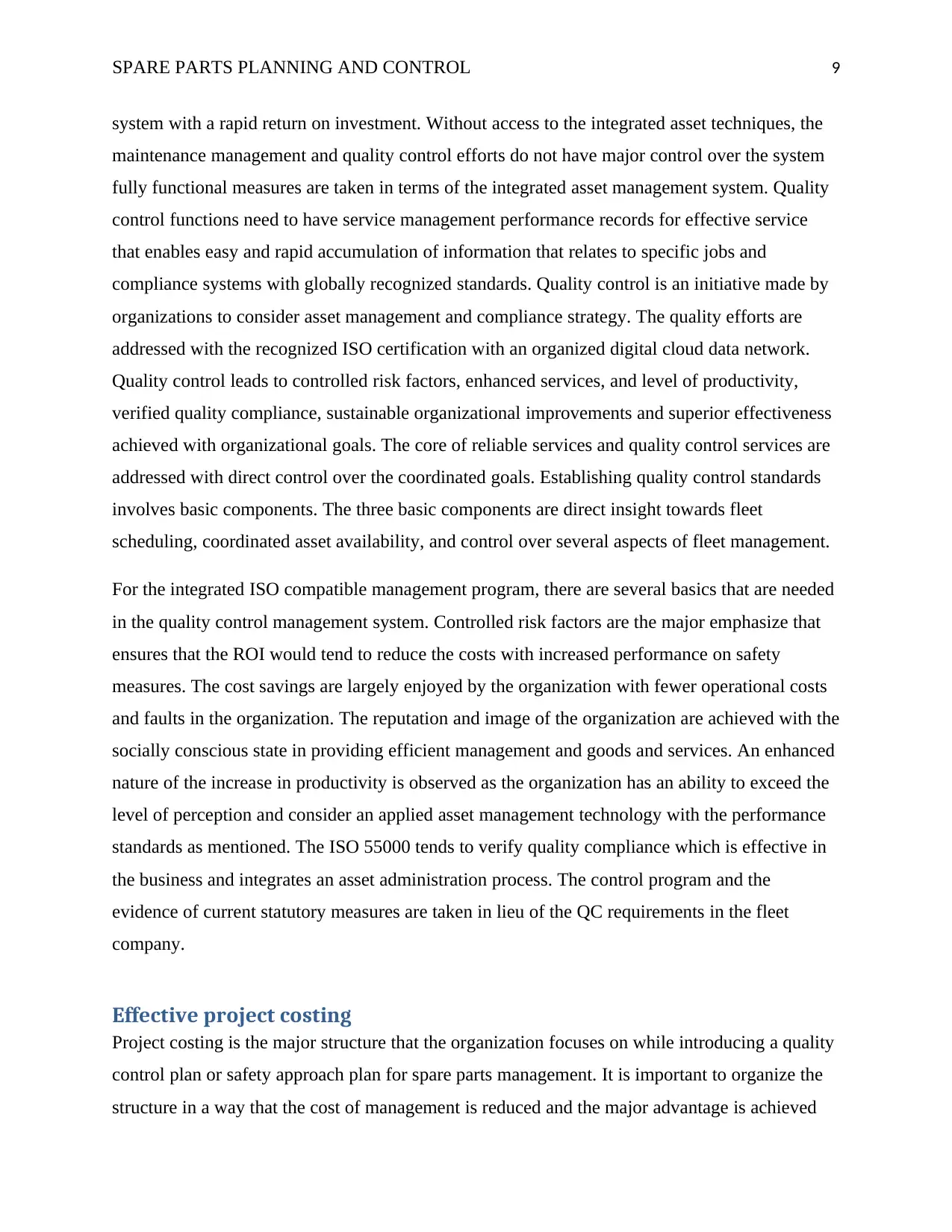
SPARE PARTS PLANNING AND CONTROL 9
system with a rapid return on investment. Without access to the integrated asset techniques, the
maintenance management and quality control efforts do not have major control over the system
fully functional measures are taken in terms of the integrated asset management system. Quality
control functions need to have service management performance records for effective service
that enables easy and rapid accumulation of information that relates to specific jobs and
compliance systems with globally recognized standards. Quality control is an initiative made by
organizations to consider asset management and compliance strategy. The quality efforts are
addressed with the recognized ISO certification with an organized digital cloud data network.
Quality control leads to controlled risk factors, enhanced services, and level of productivity,
verified quality compliance, sustainable organizational improvements and superior effectiveness
achieved with organizational goals. The core of reliable services and quality control services are
addressed with direct control over the coordinated goals. Establishing quality control standards
involves basic components. The three basic components are direct insight towards fleet
scheduling, coordinated asset availability, and control over several aspects of fleet management.
For the integrated ISO compatible management program, there are several basics that are needed
in the quality control management system. Controlled risk factors are the major emphasize that
ensures that the ROI would tend to reduce the costs with increased performance on safety
measures. The cost savings are largely enjoyed by the organization with fewer operational costs
and faults in the organization. The reputation and image of the organization are achieved with the
socially conscious state in providing efficient management and goods and services. An enhanced
nature of the increase in productivity is observed as the organization has an ability to exceed the
level of perception and consider an applied asset management technology with the performance
standards as mentioned. The ISO 55000 tends to verify quality compliance which is effective in
the business and integrates an asset administration process. The control program and the
evidence of current statutory measures are taken in lieu of the QC requirements in the fleet
company.
Effective project costing
Project costing is the major structure that the organization focuses on while introducing a quality
control plan or safety approach plan for spare parts management. It is important to organize the
structure in a way that the cost of management is reduced and the major advantage is achieved
system with a rapid return on investment. Without access to the integrated asset techniques, the
maintenance management and quality control efforts do not have major control over the system
fully functional measures are taken in terms of the integrated asset management system. Quality
control functions need to have service management performance records for effective service
that enables easy and rapid accumulation of information that relates to specific jobs and
compliance systems with globally recognized standards. Quality control is an initiative made by
organizations to consider asset management and compliance strategy. The quality efforts are
addressed with the recognized ISO certification with an organized digital cloud data network.
Quality control leads to controlled risk factors, enhanced services, and level of productivity,
verified quality compliance, sustainable organizational improvements and superior effectiveness
achieved with organizational goals. The core of reliable services and quality control services are
addressed with direct control over the coordinated goals. Establishing quality control standards
involves basic components. The three basic components are direct insight towards fleet
scheduling, coordinated asset availability, and control over several aspects of fleet management.
For the integrated ISO compatible management program, there are several basics that are needed
in the quality control management system. Controlled risk factors are the major emphasize that
ensures that the ROI would tend to reduce the costs with increased performance on safety
measures. The cost savings are largely enjoyed by the organization with fewer operational costs
and faults in the organization. The reputation and image of the organization are achieved with the
socially conscious state in providing efficient management and goods and services. An enhanced
nature of the increase in productivity is observed as the organization has an ability to exceed the
level of perception and consider an applied asset management technology with the performance
standards as mentioned. The ISO 55000 tends to verify quality compliance which is effective in
the business and integrates an asset administration process. The control program and the
evidence of current statutory measures are taken in lieu of the QC requirements in the fleet
company.
Effective project costing
Project costing is the major structure that the organization focuses on while introducing a quality
control plan or safety approach plan for spare parts management. It is important to organize the
structure in a way that the cost of management is reduced and the major advantage is achieved
⊘ This is a preview!⊘
Do you want full access?
Subscribe today to unlock all pages.

Trusted by 1+ million students worldwide
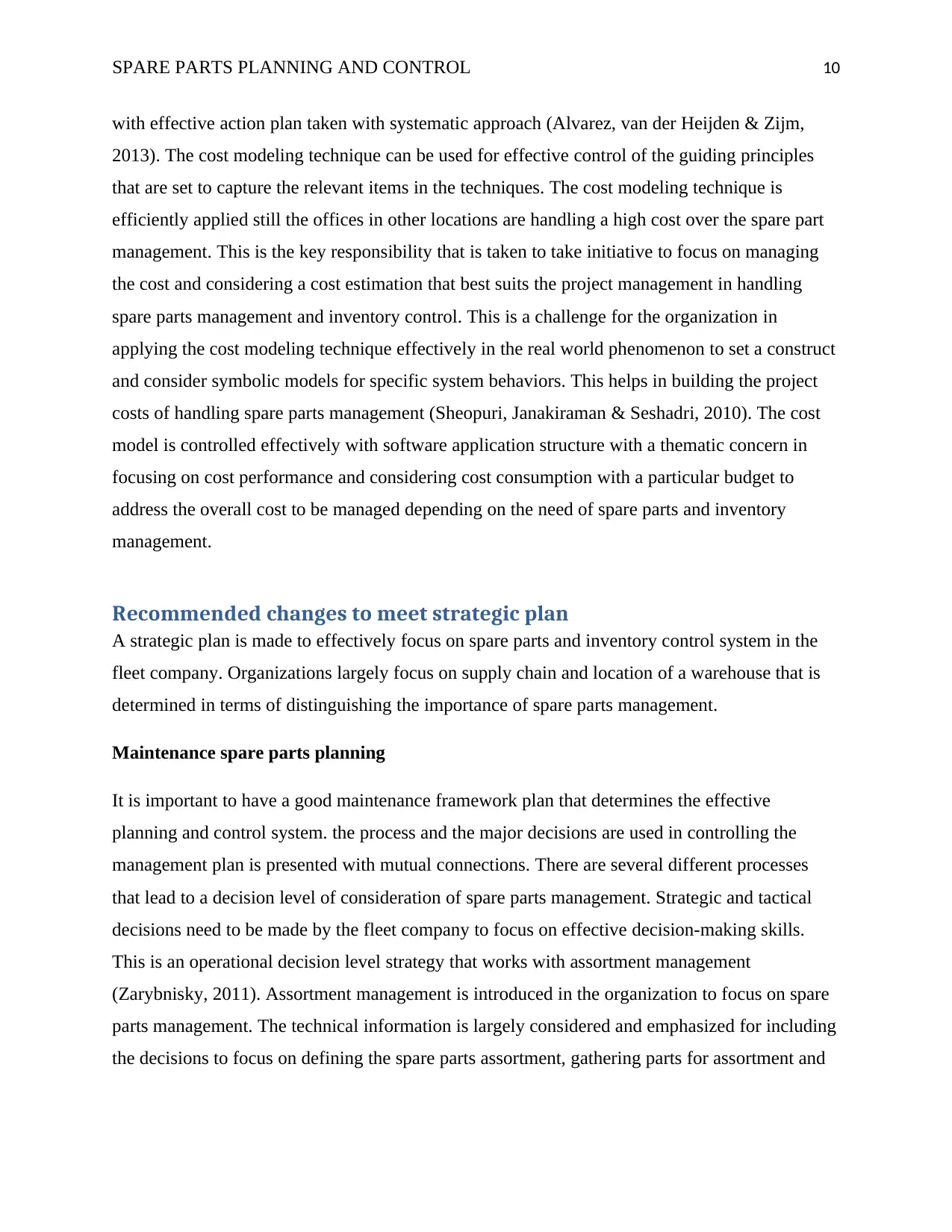
SPARE PARTS PLANNING AND CONTROL 10
with effective action plan taken with systematic approach (Alvarez, van der Heijden & Zijm,
2013). The cost modeling technique can be used for effective control of the guiding principles
that are set to capture the relevant items in the techniques. The cost modeling technique is
efficiently applied still the offices in other locations are handling a high cost over the spare part
management. This is the key responsibility that is taken to take initiative to focus on managing
the cost and considering a cost estimation that best suits the project management in handling
spare parts management and inventory control. This is a challenge for the organization in
applying the cost modeling technique effectively in the real world phenomenon to set a construct
and consider symbolic models for specific system behaviors. This helps in building the project
costs of handling spare parts management (Sheopuri, Janakiraman & Seshadri, 2010). The cost
model is controlled effectively with software application structure with a thematic concern in
focusing on cost performance and considering cost consumption with a particular budget to
address the overall cost to be managed depending on the need of spare parts and inventory
management.
Recommended changes to meet strategic plan
A strategic plan is made to effectively focus on spare parts and inventory control system in the
fleet company. Organizations largely focus on supply chain and location of a warehouse that is
determined in terms of distinguishing the importance of spare parts management.
Maintenance spare parts planning
It is important to have a good maintenance framework plan that determines the effective
planning and control system. the process and the major decisions are used in controlling the
management plan is presented with mutual connections. There are several different processes
that lead to a decision level of consideration of spare parts management. Strategic and tactical
decisions need to be made by the fleet company to focus on effective decision-making skills.
This is an operational decision level strategy that works with assortment management
(Zarybnisky, 2011). Assortment management is introduced in the organization to focus on spare
parts management. The technical information is largely considered and emphasized for including
the decisions to focus on defining the spare parts assortment, gathering parts for assortment and
with effective action plan taken with systematic approach (Alvarez, van der Heijden & Zijm,
2013). The cost modeling technique can be used for effective control of the guiding principles
that are set to capture the relevant items in the techniques. The cost modeling technique is
efficiently applied still the offices in other locations are handling a high cost over the spare part
management. This is the key responsibility that is taken to take initiative to focus on managing
the cost and considering a cost estimation that best suits the project management in handling
spare parts management and inventory control. This is a challenge for the organization in
applying the cost modeling technique effectively in the real world phenomenon to set a construct
and consider symbolic models for specific system behaviors. This helps in building the project
costs of handling spare parts management (Sheopuri, Janakiraman & Seshadri, 2010). The cost
model is controlled effectively with software application structure with a thematic concern in
focusing on cost performance and considering cost consumption with a particular budget to
address the overall cost to be managed depending on the need of spare parts and inventory
management.
Recommended changes to meet strategic plan
A strategic plan is made to effectively focus on spare parts and inventory control system in the
fleet company. Organizations largely focus on supply chain and location of a warehouse that is
determined in terms of distinguishing the importance of spare parts management.
Maintenance spare parts planning
It is important to have a good maintenance framework plan that determines the effective
planning and control system. the process and the major decisions are used in controlling the
management plan is presented with mutual connections. There are several different processes
that lead to a decision level of consideration of spare parts management. Strategic and tactical
decisions need to be made by the fleet company to focus on effective decision-making skills.
This is an operational decision level strategy that works with assortment management
(Zarybnisky, 2011). Assortment management is introduced in the organization to focus on spare
parts management. The technical information is largely considered and emphasized for including
the decisions to focus on defining the spare parts assortment, gathering parts for assortment and
Paraphrase This Document
Need a fresh take? Get an instant paraphrase of this document with our AI Paraphraser
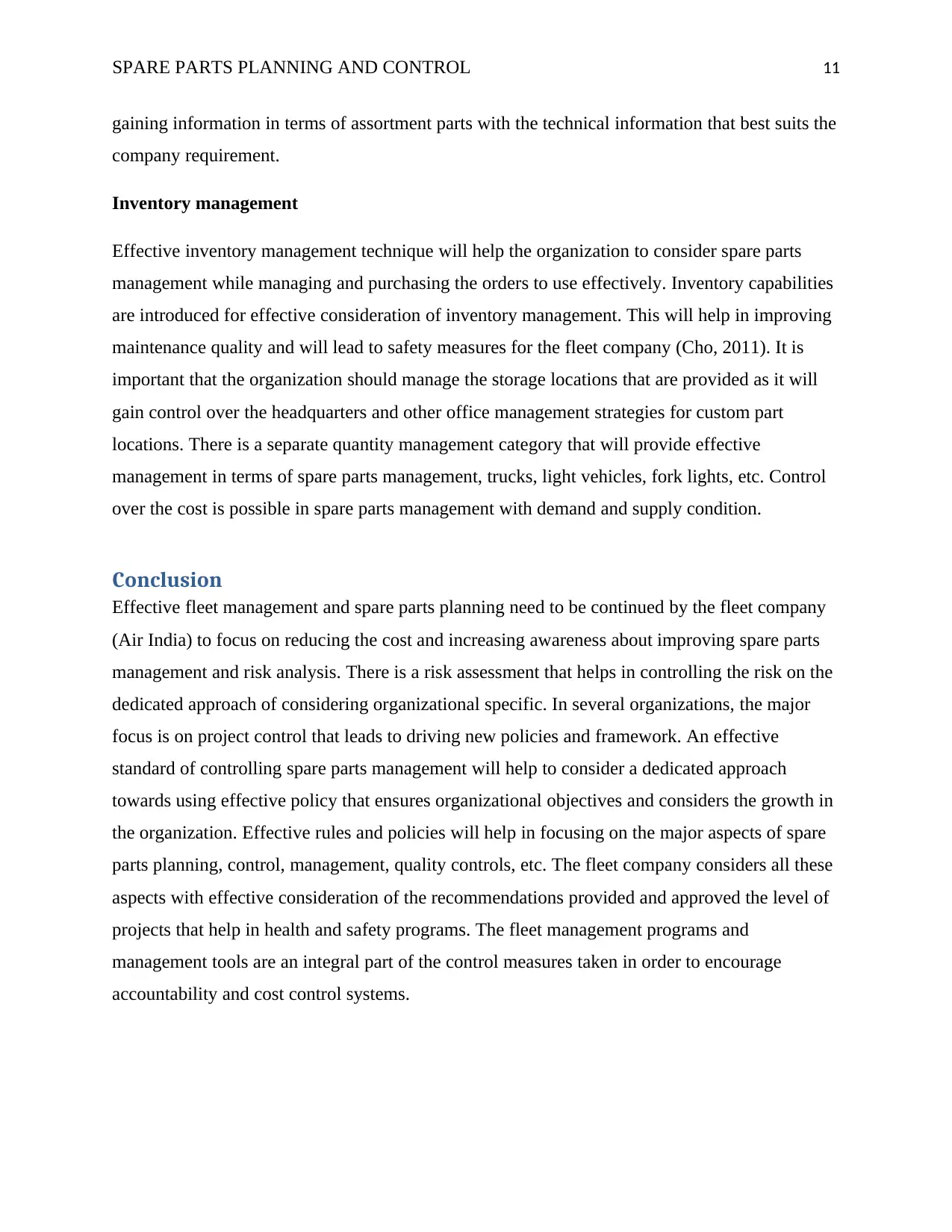
SPARE PARTS PLANNING AND CONTROL 11
gaining information in terms of assortment parts with the technical information that best suits the
company requirement.
Inventory management
Effective inventory management technique will help the organization to consider spare parts
management while managing and purchasing the orders to use effectively. Inventory capabilities
are introduced for effective consideration of inventory management. This will help in improving
maintenance quality and will lead to safety measures for the fleet company (Cho, 2011). It is
important that the organization should manage the storage locations that are provided as it will
gain control over the headquarters and other office management strategies for custom part
locations. There is a separate quantity management category that will provide effective
management in terms of spare parts management, trucks, light vehicles, fork lights, etc. Control
over the cost is possible in spare parts management with demand and supply condition.
Conclusion
Effective fleet management and spare parts planning need to be continued by the fleet company
(Air India) to focus on reducing the cost and increasing awareness about improving spare parts
management and risk analysis. There is a risk assessment that helps in controlling the risk on the
dedicated approach of considering organizational specific. In several organizations, the major
focus is on project control that leads to driving new policies and framework. An effective
standard of controlling spare parts management will help to consider a dedicated approach
towards using effective policy that ensures organizational objectives and considers the growth in
the organization. Effective rules and policies will help in focusing on the major aspects of spare
parts planning, control, management, quality controls, etc. The fleet company considers all these
aspects with effective consideration of the recommendations provided and approved the level of
projects that help in health and safety programs. The fleet management programs and
management tools are an integral part of the control measures taken in order to encourage
accountability and cost control systems.
gaining information in terms of assortment parts with the technical information that best suits the
company requirement.
Inventory management
Effective inventory management technique will help the organization to consider spare parts
management while managing and purchasing the orders to use effectively. Inventory capabilities
are introduced for effective consideration of inventory management. This will help in improving
maintenance quality and will lead to safety measures for the fleet company (Cho, 2011). It is
important that the organization should manage the storage locations that are provided as it will
gain control over the headquarters and other office management strategies for custom part
locations. There is a separate quantity management category that will provide effective
management in terms of spare parts management, trucks, light vehicles, fork lights, etc. Control
over the cost is possible in spare parts management with demand and supply condition.
Conclusion
Effective fleet management and spare parts planning need to be continued by the fleet company
(Air India) to focus on reducing the cost and increasing awareness about improving spare parts
management and risk analysis. There is a risk assessment that helps in controlling the risk on the
dedicated approach of considering organizational specific. In several organizations, the major
focus is on project control that leads to driving new policies and framework. An effective
standard of controlling spare parts management will help to consider a dedicated approach
towards using effective policy that ensures organizational objectives and considers the growth in
the organization. Effective rules and policies will help in focusing on the major aspects of spare
parts planning, control, management, quality controls, etc. The fleet company considers all these
aspects with effective consideration of the recommendations provided and approved the level of
projects that help in health and safety programs. The fleet management programs and
management tools are an integral part of the control measures taken in order to encourage
accountability and cost control systems.

SPARE PARTS PLANNING AND CONTROL 12
References
Alvarez, E.M., van der Heijden, M.C., & Zijm, W.H., (2013). The selective use of emergency
shipments for service-contract differentiation. International Journal of Production
Economics, 143:518–526.
Basten, R.J., and Van Houtum., G.J., (2013). System-oriented inventory models for spare parts.
Working Paper, Twente University.
Basten, R.J.,van der Heijden, M.C., & Schutten. J.M., (2011). A minimum cost flow model for
level of repair analysis. International Journal of Production Economics, 133(1):233–242.
Bijvank, M., and Johansen, S.G., (2012). Periodic review lost-sales inventory models with
compound poisson demand and constant lead times of any length. European Journal of
Operational Research, 220:106–114.
Burns, E., Benton, J., Ruml, W., Yoon, S., & Do. M.B., (2012). Anticipatory online planning.
Proceedings of the Twenty-Second International Conference on Automated Planning and
Scheduling (ICAPS’12). 333–337
Cho. P. Y., (2011). Optimal scheduling of fighter aircraft maintenance. Master’s thesis, Sloan
School of Management, Massachusetts Institute of Technology.
Driessen, M.A., Arts, J.J., Van Houtum, G.J., Rustenburg, W.D., & Huisman. B., (2010).
Maintenance spare part planning and control: A framework for control and agenda for
future research. Beta Working paper 325, Eindhoven University of Technology.
Ivanov. D., (2010). An adaptive framework for aligning (re)planning decisions on supply chain
strategy, design, tactics and operations. International Journal of Production Research,
48(13):3999–4017.
Kazaz, B., T. W. Sloan. (2013). The impact of process deterioration on production and
maintenance policies. European Journal of Operational Research 227 88–100.
Oner, K.B., Kiesm¨uller, G.P., & Van Houtum. G.J., (2010). Optimization of component ¨
reliability in the design phase of capital goods. European Journal of Operational
Research, 205:615–624.
References
Alvarez, E.M., van der Heijden, M.C., & Zijm, W.H., (2013). The selective use of emergency
shipments for service-contract differentiation. International Journal of Production
Economics, 143:518–526.
Basten, R.J., and Van Houtum., G.J., (2013). System-oriented inventory models for spare parts.
Working Paper, Twente University.
Basten, R.J.,van der Heijden, M.C., & Schutten. J.M., (2011). A minimum cost flow model for
level of repair analysis. International Journal of Production Economics, 133(1):233–242.
Bijvank, M., and Johansen, S.G., (2012). Periodic review lost-sales inventory models with
compound poisson demand and constant lead times of any length. European Journal of
Operational Research, 220:106–114.
Burns, E., Benton, J., Ruml, W., Yoon, S., & Do. M.B., (2012). Anticipatory online planning.
Proceedings of the Twenty-Second International Conference on Automated Planning and
Scheduling (ICAPS’12). 333–337
Cho. P. Y., (2011). Optimal scheduling of fighter aircraft maintenance. Master’s thesis, Sloan
School of Management, Massachusetts Institute of Technology.
Driessen, M.A., Arts, J.J., Van Houtum, G.J., Rustenburg, W.D., & Huisman. B., (2010).
Maintenance spare part planning and control: A framework for control and agenda for
future research. Beta Working paper 325, Eindhoven University of Technology.
Ivanov. D., (2010). An adaptive framework for aligning (re)planning decisions on supply chain
strategy, design, tactics and operations. International Journal of Production Research,
48(13):3999–4017.
Kazaz, B., T. W. Sloan. (2013). The impact of process deterioration on production and
maintenance policies. European Journal of Operational Research 227 88–100.
Oner, K.B., Kiesm¨uller, G.P., & Van Houtum. G.J., (2010). Optimization of component ¨
reliability in the design phase of capital goods. European Journal of Operational
Research, 205:615–624.
⊘ This is a preview!⊘
Do you want full access?
Subscribe today to unlock all pages.

Trusted by 1+ million students worldwide
1 out of 13
Related Documents
Your All-in-One AI-Powered Toolkit for Academic Success.
+13062052269
info@desklib.com
Available 24*7 on WhatsApp / Email
![[object Object]](/_next/static/media/star-bottom.7253800d.svg)
Unlock your academic potential
Copyright © 2020–2025 A2Z Services. All Rights Reserved. Developed and managed by ZUCOL.





